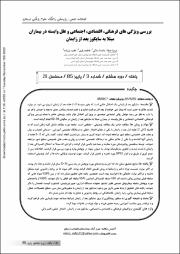| dc.contributor.author | Safa, mitra | en_US |
| dc.contributor.author | Saki, mandana | en_US |
| dc.contributor.author | Yari, fatemeh | en_US |
| dc.contributor.author | Lorzadeh, nahid | en_US |
| dc.date.accessioned | 1399-08-21T21:46:38Z | fa_IR |
| dc.date.accessioned | 2020-11-11T21:46:38Z | |
| dc.date.available | 1399-08-21T21:46:38Z | fa_IR |
| dc.date.available | 2020-11-11T21:46:38Z | |
| dc.date.issued | 2006-11-01 | en_US |
| dc.date.issued | 1385-08-10 | fa_IR |
| dc.identifier.citation | Safa, mitra, Saki, mandana, Yari, fatemeh, Lorzadeh, nahid. (2006). The effects of social, cultural, economical and related factors on post partum psychosis. scientific magazine yafte, 8(3), 31-36. | en_US |
| dc.identifier.issn | 1563-0773 | |
| dc.identifier.uri | http://yafte.lums.ac.ir/article-1-1023-en.html | |
| dc.identifier.uri | https://iranjournals.nlai.ir/handle/123456789/483486 | |
| dc.description.abstract | Background: Post partum psychosis is a mood disorder which starts 2 or 3 weeks after delivery. In acute form, the symptoms of this disorder are so obvious that the sick mother doesn’t want to take care of her child in some cases, she wants to hurt either the child or herself or both (the child & the mother). It seems that there are some psychosocial factors that cause this problem to occur.
Material and methods: The present study aims to survey the effect of social, cultural, economical and related factors on the post partum psychosis in 2003-2005. The study was cross sectional. The study included all the women who immediately return to the one of the clinical and educational centers for psychosis symptoms. All the women came to the clinics with one of the symptoms of mood disorder 3 to 12 weeks after their delivery. They were examined by psychiatrists. They were also interviewed by clinical psychologists. Those who recognized as having acute depression and psychotic symptoms were included in the study. The data were analyzed using “SPSS” software.
Results: Most of the subjects were in the range of 20-30 years old. They were housewives. In most case, they gave birth to a female newborn and the delivery was done in a normal way. Most of the patients declared that they had unplanned pregnancy. 29.6% of the patients had mental disease background. 9.1% had major depression, 5.6% had dysthymic disorder. 18.5% of the subjects had physical disease like UTI, hyper thyroid and seizure.
Conclusion: There was a significant relationship between post partum psychosis and variables such as age, education, job, and disease background, number of delivery and lack of child acceptance. It is suggested that for prevention of post partum psychosis, there should be a very suitable situation for pregnant mothers. Moreover by planning and designing educational programs, we could provide the proper background for child birth in the family. | en_US |
| dc.format.extent | 190 | |
| dc.format.mimetype | application/pdf | |
| dc.language | English | |
| dc.language.iso | en_US | |
| dc.relation.ispartof | scientific magazine yafte | en_US |
| dc.relation.ispartof | مجله علمی پژوهشی یافته | fa_IR |
| dc.subject | Post partum psychosis | en_US |
| dc.subject | Women | en_US |
| dc.subject | Mood disorder | en_US |
| dc.subject | Pregnancy | en_US |
| dc.title | The effects of social, cultural, economical and related factors on post partum psychosis | en_US |
| dc.type | Text | en_US |
| dc.type | Research | en_US |
| dc.citation.volume | 8 | |
| dc.citation.issue | 3 | |
| dc.citation.spage | 31 | |
| dc.citation.epage | 36 | |





